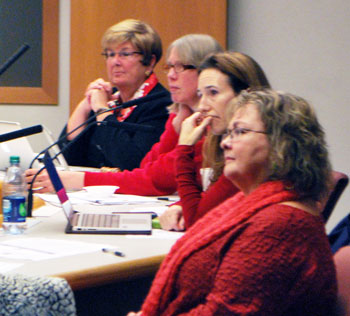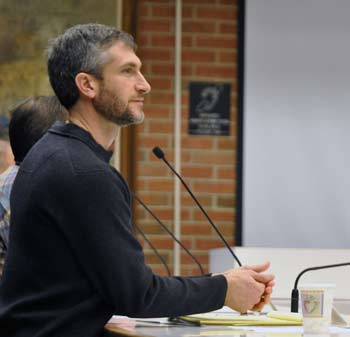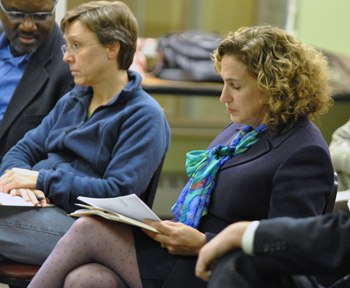Ann Arbor city council meeting (Dec. 3, 2012): One significant action taken by the council was to wrap up some unfinished business from its previous meeting – by passing a resolution that temporarily suspends paying for any new art out of public funds that have accumulated for that purpose.

At their Dec. 3, 2012 meeting, councilmembers spoke of apples-to-apples comparisons between the golf courses and other recreational activities. They also wanted apples-to-apples comparisons for changes to the Packard Square facade drawings. Planting of fruit trees also came up in the course of the meeting. Close watchers of the council might be able to identify the councilmember by the bite marks on this apple. (Photos by the writer.)
The resolution had been postponed from the council’s Nov. 19, 2012 meeting, when councilmembers also decided to table two competing proposals to change the city’s Percent for Art ordinance. One of the proposals would have repealed the ordinance, while the other would have narrowed the scope of qualifying projects. Currently the city’s Percent for Art program requires that all capital improvement project budgets include a 1% set-aside for public art.
While the moratorium on new spending is in effect – until April 1, 2013 – a council committee will study the issue. Charged with making a recommendation to the council by Feb. 15, 2013, the committee consists of Sally Petersen (Ward 2), Sabra Briere (Ward 1), Stephen Kunselman (Ward 3), Margie Teall (Ward 4) and Christopher Taylor (Ward 3). The group’s first meeting is set for Tuesday, Dec. 11 at 4 p.m. in the south first floor conference room at city hall.
The council also finished off two works in progress started at its previous meeting, when councilmembers gave initial approval to amendments to two local laws – the noise ordinance and the towing ordinance. At the council’s Dec. 3 meeting, councilmembers gave final approval to both sets of amendments. The noise ordinance was strengthened to include prohibitions of construction on legal holidays and to make supervisors responsible for infractions, in addition to those who are operating equipment. The towing ordinance clarifies the definition of inoperative vehicles so that the city can take action to prevent the storage of such vehicles on city streets.
The council also took action on an administrative decision to move the assets and liabilities of the city’s golf courses enterprise fund to the city general fund – to comply with a state treasurer’s requirement that the city have a deficit elimination plan for the golf fund. The city’s 2008 deficit elimination plan had a clearly positive effect, but did not erase the golf fund’s deficit completely. The majority of councilmembers saw a benefit to moving the accounting for golf operations into the general fund, so that the golf courses wouldn’t be singled out for different scrutiny than other recreational activities.
The council approved three separate petitions to the Washtenaw County office of the water resources commissioner, to apply for loans connected with a bit over $1 million in stormwater projects. One of those projects was a tree planting effort that would see as many as 1,000 trees planted in the fall of 2013 and spring of 2014. It generated some council conversation about tree species and how the city is planning for climate change in its selection of suitable trees.
Councilmembers also engaged in a fair amount of discussion of the color palette proposed for changes in the facade of the already-approved Packard Square project – which is to replace the derelict Georgetown Mall. Margie Teall’s view reflected that of many other councilmembers: “I just don’t like it.” They voted to postpone action on the facade changes until Jan. 7, 2013.
The council approved the purchase of additional waste carts, and designated Craig Hupy, the city’s public services area administrator, as the city’s street administrator for purposes of signing contracts with the Michigan Dept. of Transportation. The designation of Hupy in that role – instead of Homayoon Pirooz, the former head of project management with the city – highlighted the fact that Pirooz has retired to take a job with the city of Evanston, Ill.
It was the second meeting of the new edition of the council, following the Nov. 6 elections. So the council was presented with assignments to various internal committees – as well as the council’s appointments to other bodies. The departure of Tony Derezinski, Sandi Smith and Carsten Hohnke from the council meant that some changes to committee assignments had to be made. Some of changes were straight-up replacements, while others reflected some shuffling. [Google Spreadsheet with 2012 and 2013 committee appointments]
The council heard its usual range of commentary from the public – highlighted by two students from Skyline High School who spoke in support of public transportation.
Public transportation will also be the focus of a special council meeting called for Monday, Dec. 10 to discuss a possible position on state legislation regarding a regional transit authority. A proposed resolution that councilmembers will consider asks Michigan Gov. Rick Snyder to veto legislation that would establish the four-county RTA, which would include Washtenaw County. [Full Story]









